789 Lena, provisional designation 1914 UU, is a metallic asteroid from the middle region of the asteroid belt, approximately 24 kilometers in diameter. It was discovered on 24 June 1914, by Soviet–Russian astronomer Grigory Neujmin at Simeiz Observatory on the Crimean peninsula, and named after the discoverer's mother.
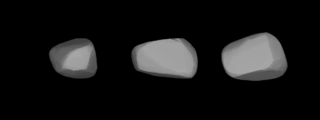
1996 Adams, provisional designation 1961 UA, is a stony Eunomia asteroid from the middle region of the asteroid belt, approximately 13 kilometers in diameter. It was discovered on 16 October 1961, by the Indiana Asteroid Program at Goethe Link Observatory near Brooklyn, Indiana, United States. It was later named after mathematician John Couch Adams.
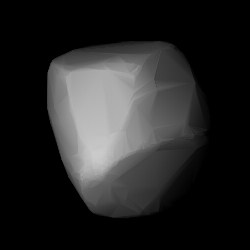
1098 Hakone is a background asteroid from the central regions of the asteroid belt. The X-type asteroid has a rotation period of 7.1 hours and measures approximately 25 kilometers in diameter. Discovered by Japanese astronomer Okuro Oikawa at Tokyo Observatory in 1928, the asteroid was later named after the volcanic Mount Hakone in Japan.
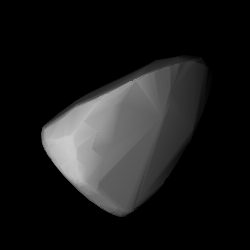
1554 Yugoslavia, provisional designation 1940 RE, is a stony Eunomian asteroid from the middle region of the asteroid belt, approximately 16 kilometres (9.9 mi) in diameter. It was discovered by Serbian astronomer Milorad Protić at Belgrade Astronomical Observatory, Serbia, on 6 September 1940. It was named for the former country of Yugoslavia.
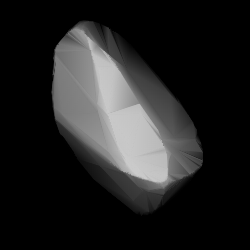
1119 Euboea is a background asteroid from the central region of the asteroid belt. It was discovered on 27 October 1927, by German astronomer Karl Reinmuth at the Heidelberg-Königstuhl State Observatory in southwest Germany. The asteroid has a rotation period of 11.4 hours and measures approximately 30 kilometers in diameter. It was named for the Greek island of Euboea.

1147 Stavropolis is a stony background asteroid from the inner regions of the asteroid belt. It was discovered on 11 June 1929, by Georgian–Russian astronomer Grigory Neujmin at the Simeiz Observatory on the Crimean peninsula. The S-type asteroid has a rotation period of 5.7 hours and measures approximately 14 kilometers in diameter. It was named after the Russian city of Stavropol.
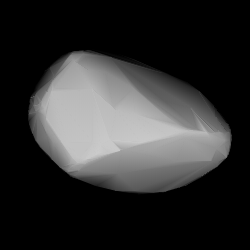
1160 Illyria, provisional designation 1929 RL, is a stony Maria asteroid from the central regions of the asteroid belt, approximately 13 kilometers in diameter. It was discovered on 9 September 1929, by German astronomer Karl Reinmuth at the Heidelberg Observatory in southwest Germany. The asteroid was named after the ancient region of Illyria, located on the Balkan Peninsula.
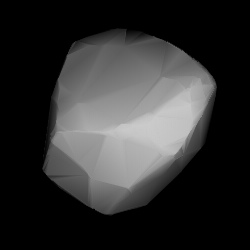
1457 Ankara, provisional designation 1937 PA, is a stony asteroid from the central region of the asteroid belt, approximately 18 kilometers in diameter. It was discovered on 3 August 1937, by German astronomer Karl Reinmuth at Heidelberg Observatory in southwest Germany, and later named for the Turkish capital city of Ankara.
1215 Boyer, provisional designation 1932 BA, is a stony Eunomian asteroid from the central region of the asteroid belt, approximately 20 kilometers in diameter. It was discovered by astronomer Alfred Schmitt in 1932, who named it after French astronomer and college Louis Boyer.
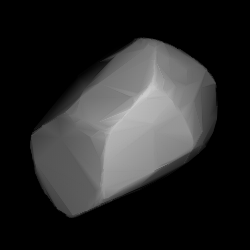
1275 Cimbria is a Eunomia asteroid from the central regions of the asteroid belt, approximately 27 kilometers in diameter. It was discovered on 30 November 1932, by astronomer Karl Reinmuth at the Heidelberg-Königstuhl State Observatory in southern Germany. The asteroid was named after the Cimbri, an ancient Germanic tribe.

2181 Fogelin is an Eunomia asteroid from the central regions of the asteroid belt, approximately 11 kilometers in diameter. It was discovered on 28 December 1942, by Germany astronomer Karl Reinmuth at the Heidelberg Observatory in southwest Germany. In 1980, it was named for Eric S. Fogelin an assistant at the Minor Planet Center. The likely elongated S-type asteroid has a rotation period of 14.07 hours.
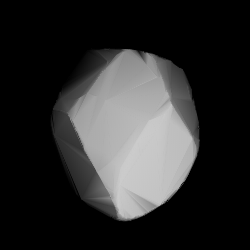
1281 Jeanne is a dark asteroid from the background population of the intermediate asteroid belt. It was discovered on 25 August 1933, by astronomer Sylvain Arend at the Royal Observatory of Belgium in Uccle, who named it after his daughter, Jeanne. The likely P-type asteroid has a rotation period of 15.2 hours and measures approximately 22 kilometers in diameter.
2187 La Silla, provisionally designated 1976 UH, is a stony Eunomia asteroid from the middle region of the asteroid belt, approximately 12 kilometers in diameter.

1332 Marconia, provisional designation 1934 AA, is a dark asteroid and the parent body of the Marconia family located in the outer regions of the asteroid belt. It measures approximately 46 kilometers in diameter. The asteroid was discovered on 9 January 1934, by Italian astronomer Luigi Volta at the Observatory of Turin in Pino Torinese, northern Italy. It was named for Italian electrical engineer Guglielmo Marconi. The uncommon L-type asteroid has a rotation period of 19.2 hours.

1841 Masaryk (prov. designation: 1971 UO1) is a carbonaceous background asteroid from the outer region of the asteroid belt, approximately 46 kilometers in diameter. It was discovered on 26 October 1971, by Czech astronomer Luboš Kohoutek at Bergedorf Observatory in Hamburg, Germany. The asteroid was named after the first President of Czechoslovakia, Tomáš Garrigue Masaryk.
2043 Ortutay, provisional designation 1936 TH, is a dark asteroid from the outer regions of the asteroid belt, approximately 45 kilometers in diameter. The asteroid was discovered by Hungarian astronomer György Kulin at the Konkoly Observatory, Budapest, on 12 November 1936. It was named after Hungarian ethnographer Gyula Ortutay.
1499 Pori, provisional designation 1938 UF, is a stony Eunomian asteroid from the central regions of the asteroid belt, approximately 15 kilometers in diameter. It was discovered on 16 October 1938, by Finnish astronomer Yrjö Väisälä at the Turku Observatory in southwest Finland. The asteroid was named after the Finnish city of Pori.

2384 Schulhof (prov. designation: 1943 EC1) is a mid-sized asteroid and the namesake of the Schulhof family, located in the Eunomian region of the intermediate asteroid belt. It was discovered on 2 March 1943, by French astronomer Marguerite Laugier at Nice Observatory in southeastern France. The asteroid was later named after Hungarian astronomer Lipót Schulhof. The presumed S-type asteroid has a short rotation period of 3.3 hours and measures approximately 12 kilometers (7.5 miles) in diameter.

6882 Sormano (prov. designation: 1995 CC1) is an stony Eunomia asteroid from the middle region of the asteroid belt, approximately 7 kilometers (4.3 miles) in diameter. It was discovered on 5 February 1995, by Italian amateur astronomers Piero Sicoli and Valter Giuliani at Sormano Astronomical Observatory in northern Italy. The asteroid was named for the Italian mountain-village of Sormano and its discovering observatory.
4085 Weir, provisional designation 1985 JR, is a stony Eunomian asteroid from the central regions of the asteroid belt, approximately 10 kilometers in diameter. It was discovered on 13 May 1985, by astronomer Carolyn Shoemaker at the Palomar Observatory in California, United States. The asteroid was named after American geologist Doris Blackman Weir.














